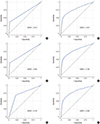1. Joyce MF, Gupta A, Azocar RJ. Acute trauma and multiple injuries in the elderly population. Curr Opin Anaesthesiol. 2015; 28:145–150.
2. Giannoudis PV, Harwood PJ, Court-Brown C, Pape HC. Severe and multiple trauma in older patients; incidence and mortality. Injury. 2009; 40:362–367.
3. Tornetta P 3rd, Mostafavi H, Riina J, Turen C, Reimer B, Levine R, Behrens F, Geller J, Ritter C, Homel P. Morbidity and mortality in elderly trauma patients. J Trauma. 1999; 46:702–706.
4. Wang SJ, Chung JM. Geriatric trauma. J Korean Geriatr Soc. 2003; 7:85–94.
5. Perdue PW, Watts DD, Kaufmann CR, Trask AL. Differences in mortality between elderly and younger adult trauma patients: geriatric status increases risk of delayed death. J Trauma. 1998; 45:805–810.
6. Osler TM, Rogers FB, Badger GJ, Healey M, Vane DW, Shackford SR. A simple mathematical modification of TRISS markedly improves calibration. J Trauma. 2002; 53:630–634.
7. Kilgo PD, Meredith JW, Osler TM. Incorporating recent advances to make the TRISS approach universally available. J Trauma. 2006; 60:1002–1008.
8. Cannon CM, Braxton CC, Kling-Smith M, Mahnken JD, Carlton E, Moncure M. Utility of the shock index in predicting mortality in traumatically injured patients. J Trauma. 2009; 67:1426–1430.
9. Birkhahn RH, Gaeta TJ, Terry D, Bove JJ, Tloczkowski J. Shock index in diagnosing early acute hypovolemia. Am J Emerg Med. 2005; 23:323–326.
10. Rady MY, Smithline HA, Blake H, Nowak R, Rivers E. A comparison of the shock index and conventional vital signs to identify acute, critical illness in the emergency department. Ann Emerg Med. 1994; 24:685–690.
11. Toccaceli A, Giampaoletti A, Dignani L, Lucertini C, Petrucci C, Lancia L. The role of shock index as a predictor of multiple-trauma patients’ pathways. Nurs Crit Care. 2016; 21:e12–9.
12. Lim SI, Lee SW, Hong YS, Choi SH, Moon SW, Kim SJ, Kim NH, Park SM, Kim JY. Shock index, serum lactate level, and arterial-end tidal carbon dioxide difference as hospital mortality markers and guidelines of early resuscitation in hypovolemic shock. J Korean Soc Emerg Med. 2007; 18:287–293.
13. Pandit V, Rhee P, Hashmi A, Kulvatunyou N, Tang A, Khalil M, O’Keeffe T, Green D, Friese RS, Joseph B. Shock index predicts mortality in geriatric trauma patients: an analysis of the National Trauma Data Bank. J Trauma Acute Care Surg. 2014; 76:1111–1115.
14. Zarzaur BL, Croce MA, Magnotti LJ, Fabian TC. Identifying life-threatening shock in the older injured patient: an analysis of the National Trauma Data Bank. J Trauma. 2010; 68:1134–1138.
15. Zarzaur BL, Croce MA, Fischer PE, Magnotti LJ, Fabian TC. New vitals after injury: shock index for the young and age x shock index for the old. J Surg Res. 2008; 147:229–236.
16. Liu YC, Liu JH, Fang ZA, Shan GL, Xu J, Qi ZW, Zhu HD, Wang Z, Yu XZ. Modified shock index and mortality rate of emergency patients. World J Emerg Med. 2012; 3:114–117.
17. Singh A, Ali S, Agarwal A, Srivastava RN. Correlation of shock index and modified shock index with the outcome of adult trauma patients: a prospective study of 9860 patients. N Am J Med Sci. 2014; 6:450–452.
18. Ro YS, Shin SD, Holmes JF, Song KJ, Park JO, Cho JS, Lee SC, Kim SC, Hong KJ, Park CB, et al. Comparison of clinical performance of cranial computed tomography rules in patients with minor head injury: a multicenter prospective study. Acad Emerg Med. 2011; 18:597–604.
19. Furmaga W, Cohn S, Prihoda TJ, Muir MT, Mikhailov V, McCarthy J, Arar Y. Novel markers predict death and organ failure following hemorrhagic shock. Clin Chim Acta. 2015; 440:87–92.
20. Choi JY, Lee WH, Yoo TK, Park I, Kim DW. A new severity predicting index for hemorrhagic shock using lactate concentration and peripheral perfusion in a rat model. Shock. 2012; 38:635–641.
21. McNab A, Burns B, Bhullar I, Chesire D, Kerwin A. An analysis of shock index as a correlate for outcomes in trauma by age group. Surgery. 2013; 154:384–387.
22. Mitra B, Fitzgerald M, Chan J. The utility of a shock index >/= 1 as an indication for pre-hospital oxygen carrier administration in major trauma. Injury. 2014; 45:61–65.










 PDF
PDF ePub
ePub Citation
Citation Print
Print




 XML Download
XML Download